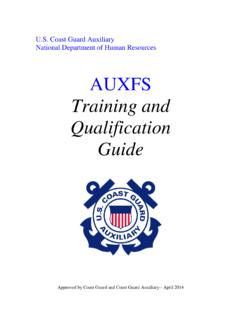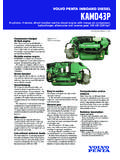Transcription of Chapter 10 Uniforms - CG Auxiliary District 11SR
1 COMDTINST 10-1 Chapter 10 Uniforms Introduction Auxiliary Uniforms are similar to those worn by Coast Guard officers. Silver braid and silver buttons replace the gold braid and buttons worn by Coast Guard officers. Auxiliarists may also wear other authorized emblems, insignia and ribbons. This Chapter provides information on the various Uniforms and their proper wear. Directors are the source of any additional information on Uniforms . All Auxiliarists are authorized and encouraged to wear the various Auxiliary Uniforms or the Blazer outfit. Auxiliarists must adhere to uniform policies when engaged in Coast Guard and Auxiliary programs and activities. Uniforms shall be worn as prescribed in Coast Guard uniform Regulations, COMDTINST (series), except as noted in this Chapter . The illustrations in this Chapter show Auxiliary Uniforms now authorized and the appearance of each uniform when worn properly.
2 A description with each picture provides guidance as to when to wear the particular uniform and specifies the individual items of clothing and accessories worn with each. When purchasing from civilian retail sources, Auxiliarists may use these descriptions for uniform items that may not otherwise be available. Also illustrated are the various insignia and devices Auxiliarists may wear on different Uniforms . They show how certain insignia identify qualifications and office (elected and appointed) status (present or past) within the Auxiliary . In this Chapter This Chapter contains the following sections: Section Title See Page A When Uniforms are Required and Prohibited 10-3 B Procurement and Disposal of Uniforms 10-7 C Standards 10-9 D uniform Components 10-15 E Auxiliary Unique Items 10-27 F uniform Accessories 10-31 G Men s Uniforms 10-55 H Men s and Women s Uniforms 10-73 I Women s Uniforms 10-87 COMDTINST 10-2 COMDTINST 10-3 Section A.
3 When Uniforms are Required and Prohibited Introduction This section describes Auxiliary procedure for proper uniform use. Auxiliary Boat Crew, Mobile Radio Facility Operators, and Shore-Side Harbor Patrols Auxiliarists onboard vessel facilities during an ordered mission shall wear the Operational Dress uniform (ODU), Working or Undress uniform , Hot Weather uniform , or the Jump Suits appropriate to the climate. In areas where required, survival suits shall be substituted for the uniform . When considered appropriate, they shall replace office insignia with the member device. uniform selection is the coxswain s choice and it shall be the same for all crew members. It shall also conform to any guidance issued by the Order Issuing Authority (OIA). With the exception of survival suit wear, the same provisions above apply to Auxiliarists involved with mobile radio facility operations and shore-side harbor patrols.
4 Appropriate foul weather gear shall be worn as circumstances warrant. Vessel Examiners (VE) Vessel Examiners (VE) may wear the ODU, Working, Undress, Jump suit, or Hot Weather Uniforms . When conducting CFVEs, VEs may wear Coast Guard issued coveralls. Auxiliarists conducting VSCs may replace the insignia of their current or highest past office with the member device. For VEs, the VE Polo shirt is authorized for wear as an optional uniform shirt worn as part of the Undress Blue Summer (Bravo), Working Blue, ODU, and Hot Weather uniform . The shirt is not authorized for wear on patrol and no insignia, name tags or breast devices shall be worn with the shirt. Headgear (when wearing the Polo shirt) shall not display office insignia. Only the member device shall be displayed on the hat. The AUXCEN carries the only shirt authorized.
5 Pilots, Air Observers, and Aircrew Pilots, air observers, and aircrew on ordered missions in aircraft facilities shall wear appropriate Auxiliary Uniforms , a Coast Guard flight suit or approved anti-exposure coveralls. The uniform selection is the Aircraft Commander s choice and shall be the same for other air crew members. Non-polyester Uniforms should be worn whenever possible. Garrison caps are authorized to be worn with flight suits and are preferred on the flight line over a ball cap as they can be folded into a pocket. Appropriate patches and name tags should be worn on the dark blue civilian-type jump suit. (see paragraph of this Chapter ) COMDTINST 10-4 Instructors (IT) and Assistants All instructors (IT) and assistant ITs in PE classes shall be in a uniform appropriate to the setting and climate. Authorized Uniforms include the Undress Blue (Alpha), Tropical Blue, Winter Dress Blue, or Service Dress Blue Uniforms .
6 The Auxiliary Blue Blazer outfit may also be worn. The uniform worn should be consistent with the one worn by the senior IT, if practical. Recreational Boating Safety Visitation Program (RBSVP) Auxiliarists serving as RBSPVs shall wear either the Service Dress Blue or Tropical Blue uniform (as appropriate for climate and geographic location) for their first visit. Uniforms are encouraged for subsequent visits, although civilian clothes are authorized. Military Air or Surface Travel Auxiliarists traveling as passengers on any Coast Guard or military air or surface craft shall dress as prescribed by local commanders. Assignment to Duty An OIA may prescribe an Auxiliary uniform as a condition for assignment to duty. Auxiliarists shall conform to Coast Guard unit policies regarding such uniform wear whenever interacting with, acting on behalf of, or representing the unit.
7 Any unresolved questions, disputes, or misunderstandings regarding such uniform wear should be referred to the Director. When performing duty on a Coast Guard vessel or unit, Auxiliarists shall wear a uniform consistent with those of the unit s personnel. Auxiliarists, when working as crew on a Coast Guard vessel or unit, shall wear only the member device on collars and the corresponding hats for such Uniforms . An Auxiliarist s actual office insignia may be worn for ceremonial events. Formal and Ceremonial Occasions Wearing of the Auxiliary uniform by active or retired Auxiliarists for formal and ceremonial occasions is authorized as follows: a. At civilian and military events requiring formal wear (Dinner Dress Blue Jacket or Dinner Dress White Jacket). Auxiliarists who do not own Dinner Dress Blue/White Jacket may wear Service Dress Blue. b.
8 Service Dress Blue or White may be worn on occasions where Coast Guard and other military personnel wear the same uniform . Coast Guard uniform Regulations, COMDTINST (series), authorizes retired Coast Guard personnel to wear the dress uniform that was prescribed at the time of their retirement, or any dress uniform that is currently authorized for active duty personnel, to certain formal and ceremonial events. The same holds true for Auxiliarists in retired status. Such events include: COMDTINST 10-5 c. Military ceremonies ( , retirements, changes of command, funerals). d. Patriotic parades on national holidays, or occasions in which active or Reserve personnel are taking part. e. Social or other functions when the invitation has been influenced by the member s prior military service. Due to the nature of certain formal Auxiliary events like changes of watch, conferences, and banquets, such events are recognized as falling within the general scope of military ceremony.
9 They are nonetheless Auxiliary events, and Auxiliarists who are invited to them are so invited because of their Auxiliary membership status, not due to a retired military status as may be held by prior active duty or Reserve personnel. Accordingly, Auxiliarists who are also retired military personnel are strongly encouraged and recommended to wear their Auxiliary dress uniform under such circumstances in lieu of any authorized military dress uniform . Prohibited Occasions Wearing of the Auxiliary uniform without proper authority is a violation of law. Prohibited occasions for wear include: a. In places of dubious reputation where the uniform might be discredited or disgraced. b. When engaged in political activities. c. During paid employment or sports. d. Aboard an Auxiliary vessel or aircraft facility unless the facility is on an authorized patrol.
10 E. Entry to or while present in a foreign country or territory unless specifically authorized by an appropriate Coast Guard authority. Authorization may be granted in the following cases: (1) A scheduled patrol or deployment that might enter foreign territories. (2) An authorized SAR mission involving foreign borders or territories. (3) Deployment or guest status aboard a Coast Guard cutter or aircraft that enters foreign territory. (4) Visiting a foreign country as an Auxiliarist on official business. Auxiliarists may not wear any distinctive part of the uniform or official Auxiliary insignia with civilian clothing when not assigned to duty. This includes Personal Protective Equipment (PPE) that is marked with wording that includes, USCG Auxiliary or any version thereof ( , life jackets, cold weather gear). COMDTINST 10-6 Categories of uniform items that do not present such distinctive appearance, and that may be worn with civilian clothing, are defined in Chapter 2 of the Coast Guard uniform Regulations, COMDTINST (series), and normally include: f.









